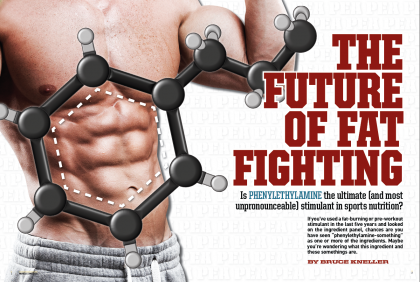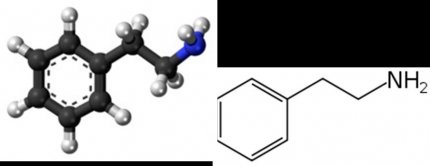The Future Of Fat Fighting

IS PHENYLETHYLAMINE THE ULTIMATE (AND MOST UPRONOUNCEABLE) STIMULANT IN SPORTS NUTRITION?
If you’ve used a fat-burning or pre-workout stimulant in the last five years and looked on the ingredient panel, chances are you’ve seen “phenylethylamine- something” as one or more of the ingredients. Maybe you’re wondering what this ingredient and these somethings are.
WHAT IS PHENYLETHYLAMINE?
Phenylethylamine (PEA) (Fig. 1 and 2) is essentially the “backbone” of almost every decent stimulant and psychoactive substance—be it drug or supplement—in the history of mankind. Its structure serves as the skeleton or foundation for ephedrine, amphetamines, hordenine, tyramine, some amino acids, and even mescaline and antidepressant drugs such as venlafaxine and bupropion, to name a few.

Figures 1 and 2
Phenylethylamines function as neuroaffectors, or, in some cases, are actually real neurotransmitters in humans (e.g., dopamine, epinephrine). The plain PEA that you see in Figures 1 and 2—as well as many derivatives—are ubiquitous in many botanicals and herbs. PEA is biogenically created in thousands of plants from the amino acid phenylalanine or tyrosine by a natural, enzymatic process. In addition to its presence in plants, PEA and its derivatives are naturally found in humans, all mammals, and most other vertebrates. PEA and some of its derivatives are commonly used as dietary ingredients in supplements and natural health products, as some of them have effects on mood and weight loss.
SOURCING PHENYLETHYLAMINES
As a whole or as a group, PEA derivatives are generally known as the phenylethylamines. I gave a few examples of derivative (or substituted) phenylethylamines, but I can’t overstate that these things are literally found everywhere and in everything—products that include stimulants, illegal psychedelic drugs, prescription anorectics, bronchodilating asthma products, hemodynamic agents, nasal decongestants, and antidepressant medications, among many, many others. In Figure 3, you’ll see all the different places on a PEA “backbone” where the molecule can be modified designated by the letter “R” with a number (or an “α,” “β” or “N”) superscripted into it.

Figure 3—Depending on where, how many, and what type of modifications are made to this PEA backbone, the clinical effects of the resultant compounds can greatly change.
Currently, there are popular PEAs in nutritional products.
- Hordenine (N,N’- dimethyl-4-hydroxy-phenylethylamine)
- Ttyramine (4-hydroxy- phenylethylamine)
- Synephrine (N-methyl-β,4-dihydroxyphenylethylamine)
- Tyrosine (α-carboxyl-4-hydroxy-phenylethylamine)
- Phenylalanine (α- carboxyl-phenylethylamine)
The above are PEA-based. Other popular PEAs that are found in plants and herbs often used in dietary products and natural health products include:
- β- methyl-phenyethylamine
- N,β-dimethyl-phenyethylamine
- N,N’-dimethyl-phenyethylamine
- N-benzoyl-phenylethylamine
| POPULAR PEAs |
|---|
|
|
|
|
PHENYLETHYLAMINES AND FAT LOSS
What’s really cool about PEA’s is that they can work directly or indirectly (or both). Oddly, the more “potent” PEAs, like antidepressants, seem to work on an indirect basis in the central nervous system (e.g., amphetamine, methamphetamine, even methylphenidate which is a PEA known more commonly as “Ritalin”). These work—de facto—by forcing higher levels of naturally occurring PEA’s in the CNS and usually have no direct effect on fat loss, heart rate or blood pressure themselves. They can blunt appetite, make you feel happy and help you to focus and feel energetic. Others have a more direct effect, binding to the adrenergic receptors in the periphery to activate lipolysis directly. The can increase heart rate, release of fatty acids into the blood stream, increase blood pressure and diuresis.
A few PEAs work by indirect and direct mechanisms. The possibilities are literally endless. Most of the better formulators I know are avidly looking at PEA-based botanical products and all are racing to find “the next big thing...the replacement for ephedrine”—be they simple PEA derivatives as I have noted or really complicated, bigger molecules like tryptamines, isoquinolones or tropane type structures, many of which have “PEA” as an integral part of their molecular structure.
THE NEXT BIG FAT BURNERThere are surely other fat burners and stimulants that are not based on PEA derivatives. The xanthines (caffeine, theophylline, paraxanthine, and theobromine to name a few) are often found in dietary supplements/natural health products and have a long history of safety and efficacy. There are plenty of non-PEA based phytochemicals that accelerate fat loss like evodiamine, pepper based ingredients, yohimbine, and the amino acid carnitine are just a few examples.
However, there are no truly exceptional “anorectics” or “appetite suppressants” that I know of that do not have PEA somewhere in their structure. So if you need a product that helps you to reduce caloric intake you’re likely to need a PEA-something.
PEAs are everywhere. In many food products you will find them and we have only just scratched the surface with these useful compounds in identifying and testing them to see “that they do.”
The future of fat loss and stimulants in our industry lies in finding and testing these PEA-type products yet to be discovered, those PEA products already known to be found in small amounts in common, and everyday herbs and foods we eat today.

